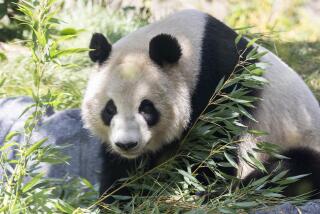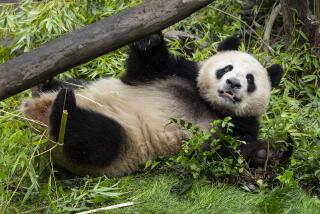Birdsâ-Eye Views : Visitors to Santa Ana Zooâs New Exhibit Will See South American Avians in All Their âColors of the Amazonâ
SANTA ANA â Zoo officials are hoping that a couple of dozen birds--from green toucanets to roseate spoonbills--will boost attendance and help convert the zoo into a showcase for South American wildlife.
Next Thursday, the Santa Ana Zoo will open a $600,000 aviary, named âColors of the Amazon,â that will allow visitors within feet of 24 birds native to South America.
Most Orange County zoo and animal experts have not yet seen the 9,000-square-foot aviary, but they applauded any new exhibit at either of the countyâs two zoos.
âWe have these two little zoos that try to do the best they can,â said Lawrence Kosmin, former president of the Zoological Society of Orange County, which supports the Orange County Zoo. âIf theyâve got something cookinâ, I think thatâs great.â
Larry Nemetz, who runs the Bird In-House Rehabilitation and Diagnostic Clinic in Santa Ana, said the colorful mix of blue, brown, pink and green birds planned for the zoo should appeal to visitors.
While most of the birds were purchased from other zoos at a total cost of about $10,000, they are native to South American and other countries throughout Central America and Mexico.
The birds include the turkey-sized greater curassow; the 7-inch, red-crested cardinal; and the more-than-2-foot-tall lanky spoonbill.
Zoo curator Connie Sweet said that because none of the birds are endangered, the aviaryâs most exotic bird will be in the eye of the beholder.
Her personal favorite, she said, is the unassuming, brown-and-black sunbittern, which stands about a foot and a half tall. When threatened, the bird spreads its wings to reveal bright splotches of red, yellow and white.
âHeâs not very big,â Sweet said, âbut he makes up for his size by the threat display.â
The aviary is part of a $10-million, 10-year plan to focus on the animals and birds of South America.
In 1993, the zoo opened the $1-million Amazonâs Edge, an exhibit that includes monkeys, swans and turtles.
The zoo plans to open an exhibit with a spectacled bear once it gathers the $1 million needed.
South America was chosen as the focus because there is not enough space to accommodate large animals native to other regions of the world such as Africa, said Friends of the Zoo Executive Director Leslie Perovich.
The aviary and other South American-themed exhibits are expected to help boost zoo attendance, which Perovich said has been rising steadily from about 230,000 annually five years ago to the current 285,000.
Perovich attributed the rise to the almost annual opening of new exhibits--a trend the zoo hopes to continue with the aviary.
Entrance to the aviary is included in the regular price of admission--$3.50 for adults--and officials hope that the birds will boost attendance by 10%, or 28,500.
Perovich acknowledged that the number of birds in the aviary may seem small, but said that will increase as the birds begin breeding. She expects up to 100 birds in five years.
The aviaryâs largest benefactor was Santa Ana, which contributed about $400,000. An additional $125,000 came from state parks and recreation funds in the form of a land and water use grant. Friends of the Zoo, a nonprofit corporation that works to promote the zoo, contributed $85,000.
After passing through an entryway with a thatched roof, visitors can walk freely among the birds as they fly overhead, scurry along the ground and roost in the trees.
An anteroom with two sets of doors and 30-foot-high âroofâ of nylon mesh netting prevents the birds from flying away.
Inside, an array of concrete walkways wrap around a waterfall, a small stream and lush vegetation including bamboo, red flowering coral trees and other plants. Other elements include geometric rock engravings meant to mimic Mayan and Aztec drawings and round timber railings.
The zoo has an aviary dedicated to African birds. Visitors cannot walk through the cage. Curassows, ducks and a Laysan teal are among the eight birds.
The zooâs other bird exhibit contains seven South American macaws. Perovich said the macaws cannot be included in the new aviary because they would chew through the nylon net.
Birds in the new aviary are inspected once a week and fed twice a day, said Sweet. They go through five pounds of food a day, ranging from seeds to live mealworms and special diets for some of the birds.
(BEGIN TEXT OF INFOBOX / INFOGRAPHIC)
New at the Zoo
On Aug. 1, the Santa Ana Zoo will open a 9,000-square-foot aviary that will allow visitors to come within feet of 24 birds native to South America. Within the confines of a mesh tent, nearly 100 birds will fly free in a subtropical setting. A look at the $600,000 facility:
Viewing Odd Birds
Visitors will want to be patient while watching birds. Some, such as the emerald toucanet, are difficult to see because they blend with colorful plant life. Two of the new cast:
Emerald toucanet
Family: Toucans
Length: 14 inches
Markings: Bright yellow and green beak; red tail feathers
Range: Mexico to Peru
*
Roseate spoonbill
Family: Ibis
Length: 32 inches
Markings: Long, flat spoon-like bill
Range: Gulf states to Argentina
*
Making a Visit
Hours: 10 a.m. to 4 p.m. weekdays; 10 a.m. to 6 p.m. weekends
Admission: $3.50; children 3 to 12 and seniors, $1.50; under 3, free
Information: (714) 836-4000
*
How You Get There
The zoo is located off the Santa Ana Freeway at 1st Street. The aviary is near the childrenâs petting zoo.
*
Sources: Santa Ana Zoo, Petersen Field Guide to Western Birds, World Book Encyclopedia; Researched by APRIL JACKSON / Los Angeles Times
More to Read
Sign up for The Wild
Weâll help you find the best places to hike, bike and run, as well as the perfect silent spots for meditation and yoga.
You may occasionally receive promotional content from the Los Angeles Times.






